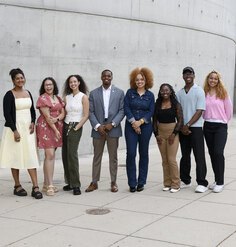Olmsted Scholar Feature: A Grand Tour of Contemporary Planting Design
By Ben O’Brien, 2014 University Olmsted Scholar
I can trace my moment of epiphany to a park tour in New York City in the summer of 2012. I was visiting with my grandmother, and the first day was devoted to the High Line. I had read every article, I had scrutinized the plans, but when I first stepped onto the old railway I was overcome, and it wasn’t because of the paving. It was because of the plants. The High Line showed me, like no other designed landscape had, the immense power of planting design. Plants became my joyful obsession, and after graduating, I felt that a “grand tour” was in order. I had to see more places like the High Line. And so it was in early September of this year that I found myself on a plane bound for England.
From the justifiably famous Piet Oudolf’s latest masterpiece for the Hauser and Wirth Gallery in Somerset, to the late Christopher Lloyd’s magnum opus at Great Dixter; from James Hitchmough’s billowing meadows and prairies at the University of Oxford Botanic Gardens and the London 2012 Olympic Park, to the remarkable subtlety of Henk Gerritsen’s gardens at Waltham Place and Dan Pearson’s poetic entry garden at London’s Garden Museum — over the course of two weeks, I was witness to an incredible range of contemporary planting.
Whether you’re weaving through the subtly contoured paths of an expansive field of flowers in Somerset, scanning the east London skyline from a ridge clothed in wildflowers, ducking and dodging luxuriant masses of plants at Great Dixter, or strolling along the cloud-pruned hedge of boxwood at Waltham Place as Mexican feather grass tickles your shins, each landscape is an experience to be savoured. In the spirit of Olmsted, these are “work[s] of art, designed to produce certain effects upon the mind of men.” Buzzing with life (human and nonhuman alike), these gardens are places with a tremendous degree of multisensory, immersive richness. Their soul gets into you and demands a slow contemplation that more superficially planted, soulless landscapes can never do. It is beauty with substance and it is a beauty that can only be achieved by people who approach their craft equipped with an encyclopaedic knowledge and vocabulary, but most of all a deeply genuine love of plants.
Through listening to Oudolf lecture at the opening of his newest garden, meeting with Hitchmough at the University of Sheffield, and from chance encounters with American designer Adam Woodruff and Waltham’s head gardener Beatrice Krehl, I was able to gain special insight into the philosophies and methodologies of these different but equally passionate plantspeople. The lessons these gardens and their creators teach are critical to both an improved, more thoughtful and rigorous approach to planting design, and to the practice of landscape architecture as a whole.
My travels reaffirmed my belief that an intellectual approach to planting design, grounded at once in science and art, is necessary if landscape architecture is to achieve its full potential as, to borrow from James Corner, an agent capable of producing and enriching a truly sustainable culture. The future of this small but important niche within the larger profession is bright, and I’m excited to play a role in its continued evolution.
Recommended reading:
Planting: A New Perspective by Piet Oudolf and Noel Kingsbury
Dream Plants for the Natural Garden by Piet Oudolf and Henk Gerritsen
The Dynamic Landscape edited by James Hitchmough and Nigel Dunnett
The Living Landscape by Rick Darke and Doug Tallamy
The Know Maintenance Perennial Garden by Roy Diblik
Principles of Ecological Landscape Design by Travis Beck
Ben O’Brien graduated with a Bachelor of Landscape Architecture (With Distinction) from the University of Guelph in Ontario, Canada and is in the process of establishing his own ecological design studio. Ben’s long-term goal is to work as a planting design consultant in partnership with leading landscape architects and urban designers.










